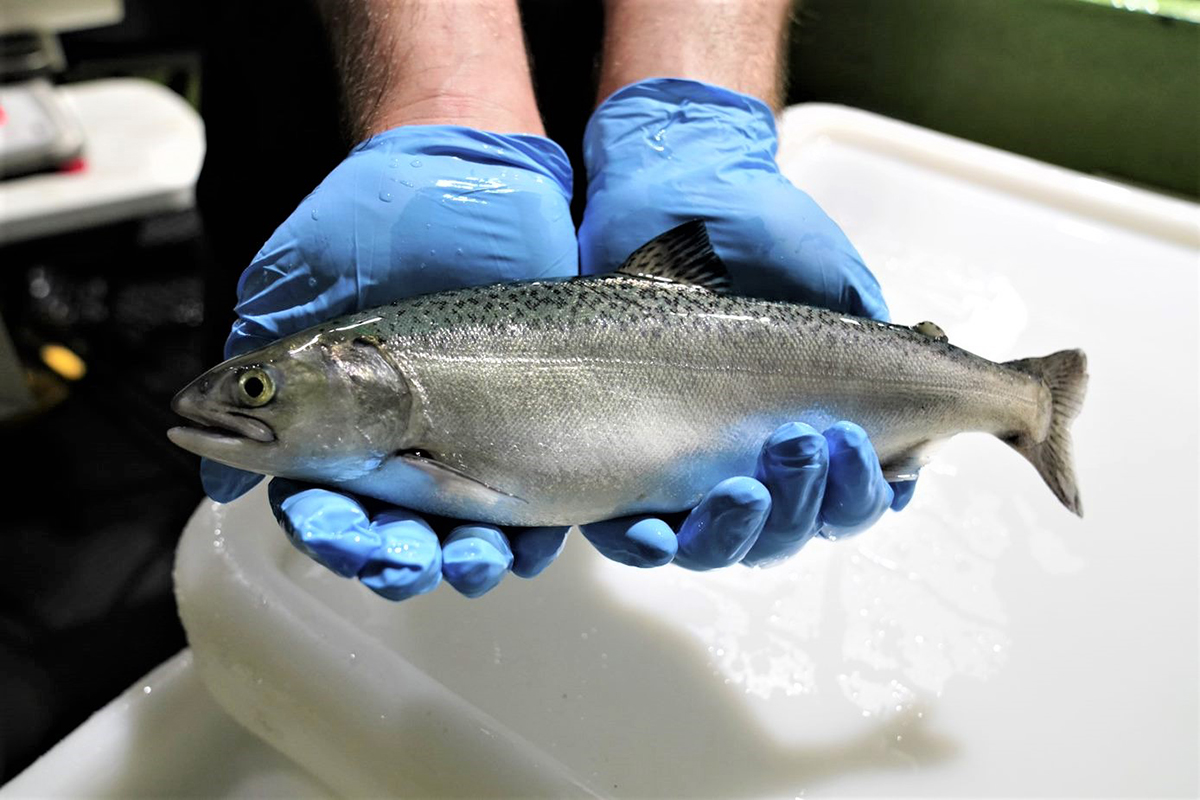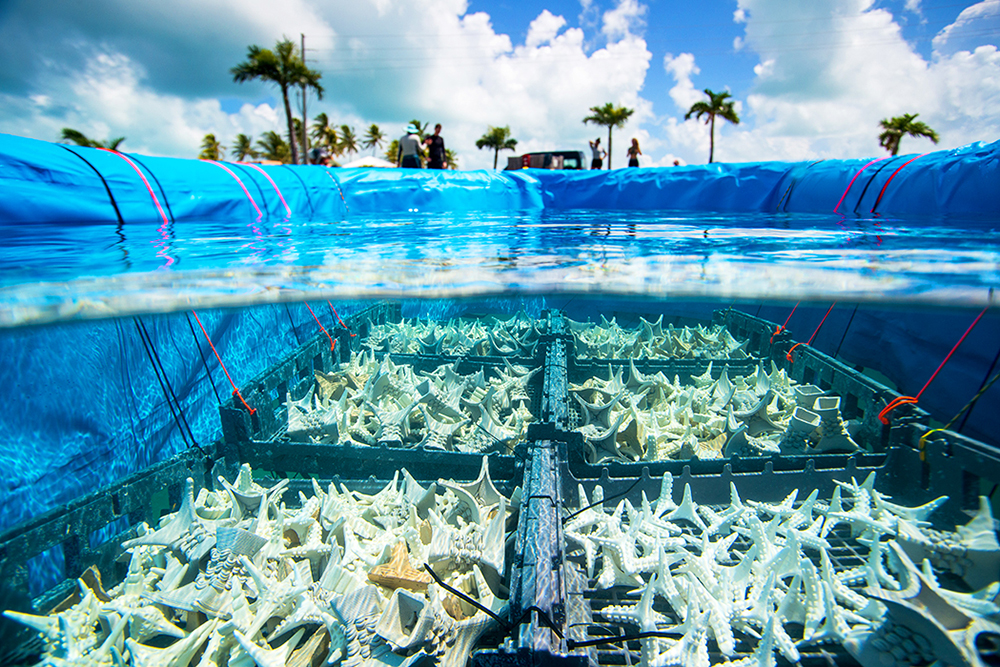Researchers at the Cawthron Institute study salmon behavior at warmer temperatures

Ocean warming is putting some fish in hot water, resulting in changes to marine habitats and fish species distribution worldwide. It’s not just wild fish that are feeling the heat: In some regions, such as the Marlborough Sounds in New Zealand, rising sea temperatures during marine heatwaves have had significant impacts, such as reduced survival on Chinook salmon farms.
In New Zealand, the impact of ocean warming on farmed salmon has driven a flurry of research into boosting resilience against climate change. One example is from the Cawthron Institute in Nelson, which has launched a new research program called Fast-Tracking Finfish Climate Change Adaptation.
Building on the institute’s salmon research and expertise, the program aims to help companies and native Māori communities develop bespoke climate change adaptation plans. It’s a combination of adaptation planning and research into future breeding strategies, understanding what might be required and whether tools such as modern genomics can assist.
Dr. Jane Symonds, senior aquaculture scientist at the Cawthron Institute, is leading the program and specializes in the application of genetics and selective breeding, including for thermotolerance. She told the Advocate that over the years, priorities have shifted, with climate change increasingly at the forefront for some companies amid the impacts of temperature change on marine ecosystems, marine life and the global food supply.
“We want to help aquaculture and partner with Māori communities to develop adaptation plans for different species,” she said. “We are working with salmon, and will also study other species like snapper, which is a culturally significant species for Māori. It’s not just about producing thermotolerant fish. It’s also about looking at other adaptation planning processes that we can introduce, as climate change impacts increase.”
When ocean temperatures reach above 62.6 degrees-F (17 degrees-C), Chinook salmon start to experience heat stress, explained Symonds. As a result, they eat less, obtain fewer nutrients and grow slower. Prolonged higher temperatures can lead to higher susceptibility to disease or mortality. In warmer areas, salmon are particularly prone to summer mortalities, while increased storms and floods are also having an impact on aquaculture.

“One of the challenges of climate change is not knowing what’s ahead,” said Symonds. “The weather and ocean temperatures are changing rapidly, and there are different scenarios out there about ocean warming. The challenge is focusing less on business as usual and looking at developing more strategic plans. We need to be proactive about how we face this uncertainty, for example, by thinking about what we will need to breed for in four or five years’ time and getting that right. If you’re breeding for the future, you must be fairly certain that that future is one you are going to experience.”
As part of the program, Symonds and her team are conducting R&D to design breeding programs for thermotolerant salmon. Selective breeding works by identifying a priority trait, such as thermotolerance, investigating whether there is a genetic component to that trait, and if there is then choosing the best individuals to breed from.
Does aquaculture really need a heat-tolerant salmon to adapt to rising ocean temperatures?
By warming water in tanks to a point that is sub-optimal for the salmon, Symonds and her team are studying how the salmon respond before picking out those that do well at higher temperatures, evaluating the data and relating them back to how the salmon would fare on farms. Work is underway to ensure that experiments on land are relevant to the ocean environment. Next steps include evaluating and comparing salmon in tanks with those in net pens, and looking at potential impacts on growth rate, flesh color and fat content.
“Working with industry partners and testing three different year classes of families, we have confirmed that thermotolerance is a highly heritable trait, with consistent results across the year classes,” said Symonds. “Almost 50 percent of the variation in thermotolerance is due to genetics. We also know that some salmon can cope with higher temperatures, keep feeding and maintain good overall health, which shows that they are truly resilient. These are very promising results.”
As well as making species more suitable for farming, selective breeding provides good returns on investment and offers certainty and predictability. Depending on the species, the process can be lengthy, said Symonds, taking a generation to produce the selected offspring and another 18 months to two years before harvesting the salmon. This means that the gains are a few years away. Despite the costs and resources needed, selective breeding is an important tool to create a stronger, more resilient salmon farming sector in New Zealand. During the research program, Symonds and her team will work with several salmon farms, tagging their fish, taking samples for genotyping and conducting thermotolerance challenges at Cawthron.
If you’re breeding for the future, you must be fairly certain that that future is one you are going to experience.
“Our data are being incorporated into farms’ breeding programs, enabling them to change their breeding strategies, look at their stock’s performance and use genotyping to obtain genetic information on how their stock is doing,” said Symonds. “Thermotolerance is probably one of the most critical traits for farming in the Marlborough Sounds right now, but we will also be working with a salmon company from Stewart Island, south of the South Island, using their breeding stock to look at thermotolerance, lower oxygen environments, stronger currents, and studying the genetic environment interactions among these environments. Disease resistance is another important area we would like to work on in the future.”
With a strong consensus toward the need to address climate change, Symonds said that there is undoubtedly a place for proactively managed fish farming across New Zealand, and genetics can play a huge role.
“Selective breeding is part of the pathway toward better climate change adaptation planning, and it’s something that we can develop with salmon farms while studying different climate change scenarios and the options for adaptation,” she said. “It plays an integral role in helping salmon farms develop plans amidst a rapidly changing environment.”
Now that you've reached the end of the article ...
… please consider supporting GSA’s mission to advance responsible seafood practices through education, advocacy and third-party assurances. The Advocate aims to document the evolution of responsible seafood practices and share the expansive knowledge of our vast network of contributors.
By becoming a Global Seafood Alliance member, you’re ensuring that all of the pre-competitive work we do through member benefits, resources and events can continue. Individual membership costs just $50 a year.
Not a GSA member? Join us.
Author
-

Bonnie Waycott
Correspondent Bonnie Waycott became interested in marine life after learning to snorkel on the Sea of Japan coast near her mother’s hometown. She specializes in aquaculture and fisheries with a particular focus on Japan, and has a keen interest in Tohoku’s aquaculture recovery following the 2011 Great East Japan Earthquake and Tsunami.
Tagged With
Related Posts

Responsibility
Are mid-depth waters off the United States East Coast getting saltier from ocean warming?
A new study indicates that mid-depth waters off the United States East Coast are getting saltier, possibly due to ocean warming caused by climate change.

Responsibility
Can artificial cooling, or thermal refuges, offset the impact of ocean warming on fish?
With ocean warming taking a toll on fish like migratory salmon, scientists are exploring artificial options to cool things down for them.

Responsibility
A wider view: Conservation aquaculture anchors coral reef restoration
Half a billion people depend on coral reefs for food, income, coastal protection and more. The need to protect and restore their biodiversity is urgent.

Responsibility
Are aquaculture and fisheries resilient enough to withstand climate change?
With most global seafood production vulnerable to the impacts of climate change, each sector faces unique adaptability obstacles and opportunities.


